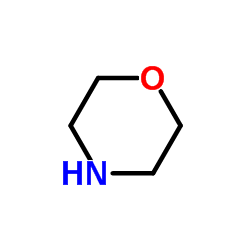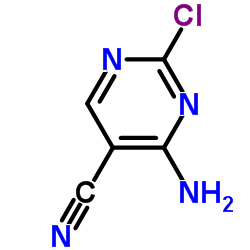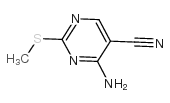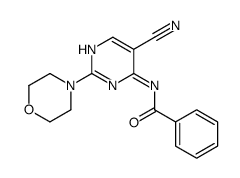78318-43-1
| Name | 4-amino-2-morpholin-4-ylpyrimidine-5-carbonitrile |
|---|---|
| Synonyms |
4-Amino-2-morpholino-pyrimidin-5-carbonitril
4-AMINO-2-MORPHOLINO-5-PYRIMIDINECARBONITRILE 4-amino-2-(4-morpholinyl)-5-pyrimidinecarbonitriIe 4-AMINO-2-(4-MORPHOLINYL)-5-PYRIMIDINECARBONITRILE |
| Density | 1.37 |
|---|---|
| Boiling Point | 490.7ºC at 760 mmHg |
| Melting Point | 232-233ºC |
| Molecular Formula | C9H11N5O |
| Molecular Weight | 205.21700 |
| Flash Point | 250.6ºC |
| Exact Mass | 205.09600 |
| PSA | 88.06000 |
| LogP | 0.41328 |
Synonym: Section 2 - COMPOSITION, INFORMATION ON INGREDIENTS
Risk Phrases: 20/21/22 Section 3 - HAZARDS IDENTIFICATION EMERGENCY OVERVIEW
Harmful by inhalation, in contact with skin and if swallowed. Potential Health Effects Eye: May cause eye irritation. Skin: May cause skin irritation. Harmful if absorbed through the skin. Ingestion: Harmful if swallowed. May cause irritation of the digestive tract. Inhalation: Harmful if inhaled. May cause respiratory tract irritation. Chronic: Not available. Section 4 - FIRST AID MEASURES Eyes: Flush eyes with plenty of water for at least 15 minutes, occasionally lifting the upper and lower eyelids. Get medical aid. Skin: Get medical aid. Flush skin with plenty of water for at least 15 minutes while removing contaminated clothing and shoes. Ingestion: Get medical aid. Wash mouth out with water. Inhalation: Remove from exposure and move to fresh air immediately. If not breathing, give artificial respiration. If breathing is difficult, give oxygen. Get medical aid. Notes to Physician: Section 5 - FIRE FIGHTING MEASURES General Information: As in any fire, wear a self-contained breathing apparatus in pressure-demand, MSHA/NIOSH (approved or equivalent), and full protective gear. Extinguishing Media: Use water spray, dry chemical, carbon dioxide, or chemical foam. Section 6 - ACCIDENTAL RELEASE MEASURES General Information: Use proper personal protective equipment as indicated in Section 8. Spills/Leaks: Vacuum or sweep up material and place into a suitable disposal container. Section 7 - HANDLING and STORAGE Handling: Avoid breathing dust, vapor, mist, or gas. Avoid contact with skin and eyes. Storage: Store in a cool, dry place. Store in a tightly closed container. Section 8 - EXPOSURE CONTROLS, PERSONAL PROTECTION Engineering Controls: Use adequate ventilation to keep airborne concentrations low. Exposure Limits CAS# 78318-43-1: Personal Protective Equipment Eyes: Not available. Skin: Wear appropriate protective gloves to prevent skin exposure. Clothing: Wear appropriate protective clothing to prevent skin exposure. Respirators: Follow the OSHA respirator regulations found in 29 CFR 1910.134 or European Standard EN 149. Use a NIOSH/MSHA or European Standard EN 149 approved respirator if exposure limits are exceeded or if irritation or other symptoms are experienced. Section 9 - PHYSICAL AND CHEMICAL PROPERTIES Physical State: Solid Color: Not available. Odor: Not available. pH: Not available. Vapor Pressure: Not available. Viscosity: Not available. Boiling Point: Not available. Freezing/Melting Point: 229 - 231 deg C Autoignition Temperature: Not available. Flash Point: Not available. Explosion Limits, lower: Not available. Explosion Limits, upper: Not available. Decomposition Temperature: Solubility in water: Specific Gravity/Density: Molecular Formula: C9H11N5O Molecular Weight: 205.22 Section 10 - STABILITY AND REACTIVITY Chemical Stability: Not available. Conditions to Avoid: Incompatible materials. Incompatibilities with Other Materials: Strong oxidizing agents. Hazardous Decomposition Products: Hydrogen cyanide, nitrogen oxides, carbon monoxide, carbon dioxide. Hazardous Polymerization: Has not been reported Section 11 - TOXICOLOGICAL INFORMATION RTECS#: CAS# 78318-43-1 unlisted. LD50/LC50: Not available. Carcinogenicity: 4-Amino-2-morpholino-5-pyrimidinecarbonitrile - Not listed by ACGIH, IARC, or NTP. Section 12 - ECOLOGICAL INFORMATION Section 13 - DISPOSAL CONSIDERATIONS Dispose of in a manner consistent with federal, state, and local regulations. Section 14 - TRANSPORT INFORMATION IATA Shipping Name: NITRILES, SOLID, TOXIC, N.O.S.* Hazard Class: 6.1 UN Number: 3276 Packing Group: III IMO Shipping Name: NITRILES, TOXIC, N.O.S. Hazard Class: 6.1 UN Number: 3276 Packing Group: III RID/ADR Shipping Name: NITRILES, TOXIC, N.O.S. Hazard Class: 6.1 UN Number: 3276 Packing group: III Section 15 - REGULATORY INFORMATION European/International Regulations European Labeling in Accordance with EC Directives Hazard Symbols: XN Risk Phrases: R 20/21/22 Harmful by inhalation, in contact with skin and if swallowed. Safety Phrases: S 36/37 Wear suitable protective clothing and gloves. WGK (Water Danger/Protection) CAS# 78318-43-1: No information available. Canada None of the chemicals in this product are listed on the DSL/NDSL list. CAS# 78318-43-1 is not listed on Canada's Ingredient Disclosure List. US FEDERAL TSCA CAS# 78318-43-1 is not listed on the TSCA inventory. It is for research and development use only. SECTION 16 - ADDITIONAL INFORMATION N/A |
| Hazard Codes | Xn:Harmful; |
|---|---|
| Risk Phrases | R20/21/22 |
| Safety Phrases | S36/37 |
|
~87% 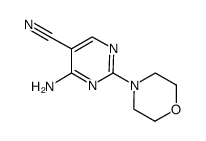
78318-43-1 |
| Literature: Schmidt, Hans-Werner; Koitz, Gerald; Junek, Hans Journal of Heterocyclic Chemistry, 1987 , vol. 24, p. 1305 - 1307 |
|
~86% 
78318-43-1 |
| Literature: Kristen, Helmut; Raddatz, Marianne Zeitschrift fuer Chemie (Stuttgart, Germany), 1981 , vol. 21, # 3 p. 101 |
|
~% 
78318-43-1 |
| Literature: Synthetic Communications, , vol. 36, # 20 p. 2963 - 2973 |
|
~% 
78318-43-1 |
| Literature: Journal of Heterocyclic Chemistry, , vol. 24, p. 1305 - 1307 |
|
~% 
78318-43-1 |
| Literature: Synthetic Communications, , vol. 36, # 20 p. 2963 - 2973 |
| Precursor 6 | |
|---|---|
| DownStream 1 | |
